What diseases can rabbits have?
Diseases of rabbits occur regardless of breed, conditions of detention, age. Most cases of rabbit disease occur due to the fact that the animals' immunity decreases, and this weakens their natural defenses and resistance to bacteria and viruses.
- Rabbit disease symptoms
- Rabbit disease groups
- Infectious disease group
- Listeriosis
- Myxomatosis
- Hemorrhagic disease
- Pasteurellosis
- Infectious conjunctivitis
- Trichophytosis
- Stomatitis
- Non-communicable diseases of rabbits
- Diseases of the musculoskeletal system
- Diseases of the gastrointestinal tract
- Skin diseases
- Dental diseases
- Invasive group of diseases
- Arachnosis
- Entomosis
- Helminthiasis
- Protozoan
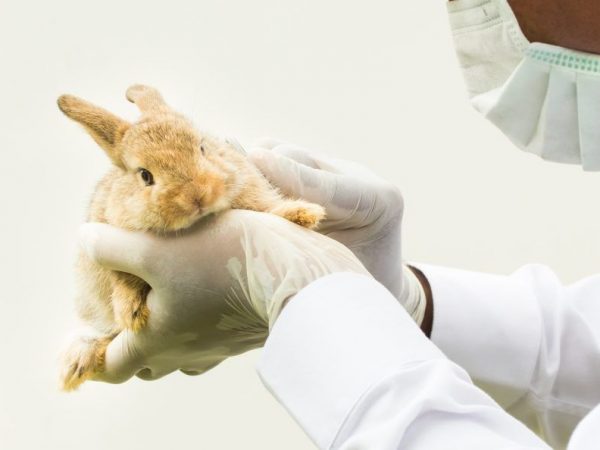
Varieties of diseases in rabbits
Everyone involved in rabbit breeding is simply obliged to understand the diseases of pets in order to recognize the alarming symptoms in time and start treating rabbit diseases. Let's talk about what the symptoms and treatment can be, why rabbits get sick and how dangerous rabbit diseases are.
Rabbit disease symptoms
You can suspect that something is wrong with your pet by the presence of certain signs and symptoms. This is typical both for infectious diseases of rabbits and for viral ones. The danger lies in the fact that the symptoms do not appear immediately: valuable time can be lost and treatment is not started at the right time. It is important to understand how to treat rabbits.
There is a list of common symptoms that should alert and cause a visit to the veterinarian. Among them:
- Diarrhea (loose and frequent stools) or constipation.
- Frequent urination (this indicates that he has kidney problems, such as cystitis).
- Shiver.
- White, uncharacteristic discharge from the eyes or nose (may indicate a common cold).
- Unusual, too active or passive behavior.
- Unquenchable thirst.
- Intermittent and heavy breathing (this may indicate the development of encephalozoonosis or tympania - the most severe pathology of the heart).
- Cough or hoarseness.
- The appearance of sores, rashes, or wounds on the skin.
- Change in the quality of the wool (it becomes rare and dull).
- Signs of the presence of parasites.
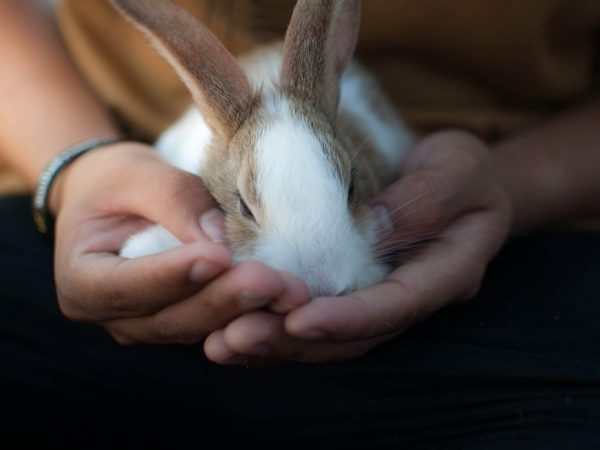
List of symptoms of rabbit diseases
Even one of the above signs can be a wake-up call that the rabbit is suffering from a dangerous disease that threatens the entire livestock. It is necessary to carefully monitor the slightest deviations in the behavior and well-being of the animal in order to take timely measures.
First of all, the animal is placed in a separate cage or aviary, after which a veterinarian is invited for consultation. He will select the right treatment and prescribe the right dosage of drugs. It is recommended not to self-medicate, since it can be extremely difficult to make the correct diagnosis and find the right dose of medicine on your own at home.
Rabbit disease groups
There is a generally accepted differentiation of rabbit diseases. They are usually divided into 3 groups:
- Diseases caused by infection (mycoplasmosis, listeriosis, myxomatosis, and so on).
- Non-communicable diseases (non-communicable).
- Parasitic lesions.
The first group is the most numerous.There are infectious diseases of rabbits that cannot be treated either at home or in a clinic. Such animals are slaughtered, and their corpses are disposed of.
There are also diseases that can be transmitted to humans, so it is important to observe all the necessary precautions. Even if a rabbit has received the necessary treatment and no longer shows any painful symptoms, this does not mean that it is not a carrier of the virus.
The second group combines diseases that arise because the owners of pussies neglect the conditions of detention and basic care. The plus is that such diseases are not dangerous to other animals and are not contagious. Livestock breeders associate the presence of non-infectious diseases with the fact that rabbits are quite picky animals, especially if they belong to decorative breeds.
The third group includes diseases caused by parasites. Such ailments are also called invasive. On rabbits, protozoa, helminths and some insects can parasitize, and both the skin and internal organs can be affected.
Infectious disease group
Infectious diseases are considered the most dangerous, as they develop quickly and rapidly affect the rabbit's body. In many cases, the success of recovery depends on whether the owner was able to understand in time that something was wrong with the pet, whether the treatment was timely. Let's talk about the most common ailments and describe their symptoms.
Listeriosis
Listeriosis is an infectious disease that affects the rabbit's liver. Not only an animal can get sick, but also a person caring for it. The immediate causative agent is Listeria, which can survive for a fairly long time in its natural environment: on leaves, grass, ground or water. Rabbits who are in position are most susceptible to infections. Often, in parallel with listeriosis, rabbits develop rabbit mastitis, endometritis and other ailments of the genital organs.
Symptoms may not appear for a month, the incubation period is so long. However, this is followed by sudden paralysis of the rabbits' hind legs, as well as tremors and convulsions throughout the body. Unfortunately, at the moment there is no cure for listeriosis, so in most cases the animal dies on its own or is slaughtered so as not to prolong its agony. This is also necessary in order to minimize the risk of infection of other animals and people in contact with a sick individual.
There are several forms of listeriosis: acute, hyperacute and chronic. If, in an acute course, there is still a chance of curing a rabbit, albeit a scanty one, then in a hyperacute stage, there is no chance at all. The chronic stage is another matter: in this case, the female has a chance of cure, although the rabbit cannot be saved from a fatal disease. However, it is no longer possible to use such a female for breeding, since the likelihood of cannibalism or the birth of dead rabbits is high.
Myxomatosis
Another dangerous infectious disease in rabbits is myxomatosis. Outbreaks of the disease usually occur in the summer. It is carried by blood-sucking insects (mosquitoes, mosquitoes, gadflies, etc.), and not only rabbits and other domestic animals can get sick, but also those that live in their natural environment. These facts influence the fact that myxomatosis spreads extremely quickly and rapidly. The positive point is that it is still possible to defeat the disease, despite its insidiousness.
The incubation period usually lasts about 2 weeks and up to a month, after which the first symptoms appear. If bumps, tumors or balls appear that are swollen and filled with fluid on the rabbit's body, this is an edematous form that cannot be defeated.If the body has developed many small nodules rather than abscesses, prompt treatment is likely to help and be effective.
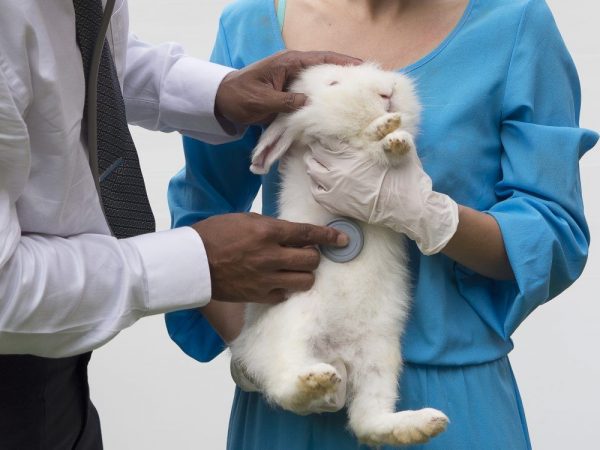
Rabbit infectious diseases
What other symptoms speak of myxomatosis in rabbits:
- an increase in body temperature up to 42-43 ° С;
- change in the nature of breathing;
- pus from the nose and eyeballs;
- general weakness and muscle atony;
- swelling;
- the presence of fibrous tissue nodules.
If you suspect the presence of myxomatosis in animals, do not postpone a visit to the veterinarian, because treatment should be started immediately. It is advisable to do this as soon as possible. After slaughter, the meat of rabbits suffering from myxomatosis during life cannot be eaten. It is recommended to carry out timely vaccination against myxomatosis and give rabbits a complex of vitamins, for example, citrovine: this will develop immunity to the pathogen and prevent infection.
Hemorrhagic disease
Rabbit viral hemorrhagic disease can be ranked first in terms of danger and insidiousness. The fact is that, having fallen ill with her once, even after all the rabbits are destroyed and disposed of, there is a possibility that the virus will survive and become the cause of the defeat of new individuals. Even the well-known chloroform and methylene are not able to destroy the virus in the room or in the natural environment. For a small rabbit to get sick, 1 minimum contact is enough.
Who is at risk? The most susceptible to the disease are young rabbits, starting from 2 months of age, and adult rabbits up to 6 years old. However, pregnant and lactating rabbits are most often threatened.
The disease can be in a dormant state for 2-3 days, like rabies, after which the first alarming symptoms appear, which are rapidly increasing. It will be possible to notice violations on the part of the respiratory system: the mucous membrane will turn blue, red blood discharge from the nose, anus, genitals and mouth will certainly appear. In this state, the rabbit lives for 2 days, after which death occurs.
The actual cause of death in IHD is pulmonary edema. Sometimes, when the disease takes on a hyperacute form, the rabbit dies instantly. It looks something like this: an absolutely healthy animal suddenly freezes for no apparent reason, falls on its paws, convulses, knocks with its front and hind legs and dies. The only salvation from VGBK can be vaccination, which was developed by the famous Soviet veterinarian V.V. Mosin.
Pasteurellosis
Pasteurella causes pasteurellosis, which does not survive well in environmental conditions and is easily destroyed with traditional disinfectants. The danger lies in the fact that a person can also get sick with pasteurellosis, having become infected during contact with a sick rabbit or during the cleaning of cages and aviaries. Despite the fact that for humans, pasteurellosis is not fatal, for rabbits the outcome is predetermined in 60% of cases.
If the course of the disease is hyperacute, the rabbit dies without showing symptoms of the disease. When it comes to the acute form, the symptoms are as follows:
- The temperature rises to 42-43 ° С, then a sharp drop to critical levels.
- Typical symptoms of acute respiratory infections, that is, sneezing, snorting, coughing and nasal discharge.
- Deterioration of the quality of the wool: it falls out and becomes dull, the skin peels off.
- A wobbly and uncertain gait, the rabbit's paws move apart in different directions (this may be a symptom of distemper).
- Redness of the mucous membrane of the eyes.
- Decreased appetite, rabbit refuses water.
- Vomiting.
The duration of the onset of symptoms is 5-10 days
Despite the fact that pasteurellosis can be treated, in most cases, rabbits still die. It is strictly forbidden to eat the meat of such an animal after slaughter, since its composition has been changed by the disease and can be dangerous to humans.
It is important to carry out prophylaxis on time in order to protect individuals who did not show symptoms, that is, they are either healthy or suffer from latent pasteurellosis. Also, do not forget about timely vaccination.
Infectious conjunctivitis
A simple disease like conjunctivitis is also caused by bacteria or viruses, but the most common causative agent is adenovirus or maximatosis. What symptoms occur in this case:
- The rabbit's eyes are tearing, pus is released.
- Lasting irritation appears, vowel blood vessels burst.
- The conjunctiva is swollen and red.
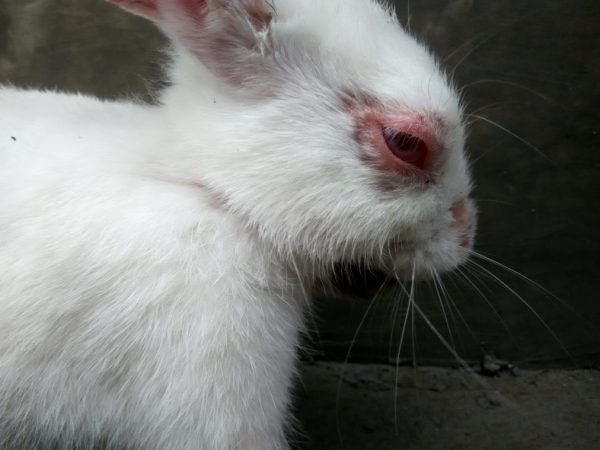
Rabbit conjunctivitis symptoms
It is not recommended to treat conjunctivitis on your own; for this you need to seek help from a veterinarian. This must be done, because the disease spreads quickly among the entire livestock of animals. Similar symptoms occur with keratitis in rabbits and hares.
Trichophytosis
Trichophytosis, or ringworm in rabbits, is quite common. It is easy to recognize its presence: the animal becomes bald, areas with loose hair appear on its skin, which are covered with a dense dry crust, dandruff may appear.
The onset of the disease marks a red spot on the rabbit, which subsequently grows and becomes larger. It is especially dangerous that both other rabbits and humans can become infected. What causes the disease? This is a mushroom called Trichophyton. It is difficult to remove it, because it is resistant to standard disinfectants.
The carriers of lichen are small rodents. Infection manifests itself in areas with lost hair on the body, usually the area of the eyes, cheeks, chin and neck, ears and paws. Calluses appear, the disease spreads to the nails.
Stomatitis
Infectious stomatitis most often affects young rabbits, starting from the age of 2-3 weeks, ending with three months. Mock, or stomatitis, is classified as a dental disease, although its symptoms are somewhat unusual. In a rabbit, saliva production increases, and the nose also becomes excessively wet. These same symptoms may indicate that the rabbit is developing ear problems.
In the mouth of the pet, the presence of many ulcers is found, including on the tongue. Bumps grow on or near the nose. Also, most likely, behavior will change, the animal will become passive and immobile, weaken. Appetite will deteriorate or disappear completely.
Despite the fact that the disease is extremely contagious, stomatitis in rabbits can be successfully treated with antibiotics (most often bikeoks for rabbits, baytril, cyprovin, penicillin, bicillin or analogs are used) and is not dangerous to humans.
Non-communicable diseases of rabbits
As mentioned earlier, the group of non-communicable ailments combined those types of diseases that are not caused by viruses or bacteria. These include disorders in the digestive system, disorders of the musculoskeletal system, for example, torticollis, as well as non-infectious rashes on the skin.
Diseases of the musculoskeletal system
This group includes any types of pathologies associated with the work of muscles, joints, bone structure, etc. If we are talking about muscle tissue, then the first disease worth mentioning is myositis and myopatosis. The first ailment is muscle inflammation, which develops as a complication after a viral or bacterial infection. The second type, myopatosis, is an acquired dysfunction of the contractile function of muscle tissue, which appeared due to the fact that the rabbit was forced to be in one position for a long time. The lack of vitamins in the rabbit's diet may indicate the development of rickets.
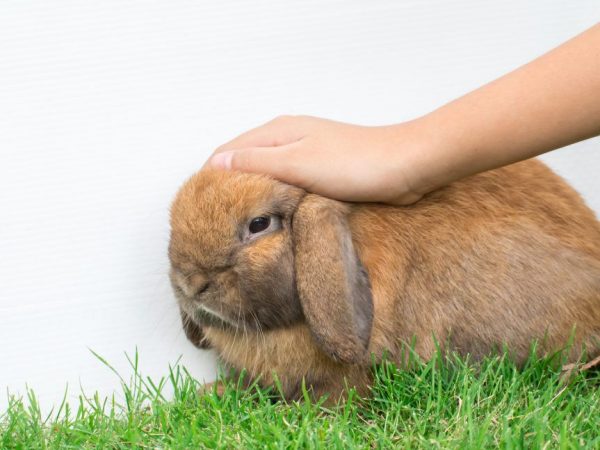
Non-communicable diseases of rabbits
As for the bones, they are affected by such diseases as osteitis, periostitis, bone necrosis, osteomyelitis, etc. All these conditions arise because a purulent process develops in the bone.The reason for this condition may also be trauma or vitamin deficiency in a rabbit, if you do not drink it with vitamin complexes or mineral solutions in time.
Joints can be damaged due to an injury, sprain, dislocation, subluxation or, much worse, arthritis or arthrosis. All these diseases can be easily diagnosed independently, for this you need to closely monitor the health of the animal, pay attention to the gait and appearance of the joints.
Diseases of the gastrointestinal tract
This subgroup is found quite often in rabbits, regardless of breed, color, age and keeping methods. The root cause of gastrointestinal problems is poor-quality feed or its imbalance. What symptomatology prevails in the intestinal group:
- Diarrhea, loose, frequent stools, possible mucus.
- Constipation, that is, the absence of feces for several days.
- The rabbit became less active and mobile.
- The appetite was broken.
- Flatulence and bloating: the belly swells up so that it can be seen with the naked eye
It is worth noting that the list did not include such a symptom as a rise in temperature, which most often indicates that the rabbit is sick with an infection or a virus. For example, intestinal enteritis. Despite the harmlessness of the symptoms, rabbits often die from a common eating disorder. The immediate cause of death is dehydration and wasting of the body.
Skin diseases
Any rash or neoplasm on the rabbit's skin is easy to notice during an external examination, which should be periodically carried out as a prophylaxis against rabbit diseases. The following symptoms can be noted:
- Hair loss.
- The coat changes its appearance, becomes dull and loses its luster.
- Roughness and spots, wounds and irritations appear on the skin, which can be healed by treatment with local wound healing agents, for example, iodine solution.
The cause of this condition is most often mechanical injury and impact: burns, hypothermia, or trauma. The latter include bruises, sprains, fractures, as well as mechanical eczema and dermatitis.
Dental diseases
Rabbits very often suffer from dental diseases. This is the most common reason a farmer visits a veterinarian's office. The fact is that untreated teeth sometimes cause much bigger problems: suppuration of the gums and even inflammation of the bones of the jaw and skull. Dental problems can be acquired or congenital, although this information will not affect the course of treatment in any way.
The most common dental disease in rabbits is malocclusion. This ailment is characterized by the fact that the rabbit's teeth grind off incorrectly, sharp formations are formed, which subsequently injure the mucous membrane of the animal's mouth. The treatment is as follows: under anesthesia, the rabbit's teeth are grinded so that they no longer harm him.
Invasive group of diseases
The final group of rabbit ailments are invasive diseases, that is, those that are caused by parasites. Once in the rabbit's body, the parasite firmly and permanently settles in it, sucking out all the strength and energy, worsening the quality of life through constant bites. A rabbit cannot get rid of parasites on its own, so the owner must help the pet in time. Within this group there is a division into subgroups, namely arachnosis, entomosis, helminthiasis and protozoosis.
Arachnosis
This subgroup is characterized by the fact that the rabbit becomes infected with subcutaneous mites that feed on blood. In addition to the fact that ticks cause some discomfort to the animal, they, in turn, can be carriers of other, more dangerous diseases.
Ticks are most commonly found on the belly and back of a rabbit, inside the ears, or on the chest. If a parasitic insect is found, it is urgent to remove it and treat the wound with an iodine solution.At the same time, it is important to do it correctly, so as not to break off the head of the tick and leave it to rot under the skin.
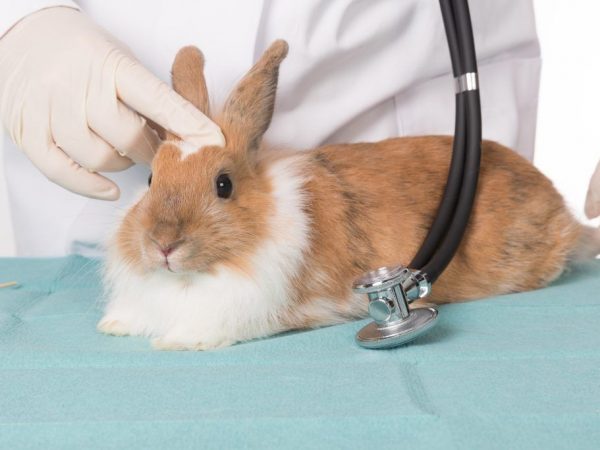
Prevention and treatment of rabbits
On hearing a lot of folk remedies, supposedly helping to get rid of parasites. Veterinarians strongly discourage their use: they will only worsen an already dangerous situation. To remove the tick from the rabbit's body, you need to gently pick up its head and remove it counterclockwise with twisting movements, and then apply an iodine solution to the wound.
Entomosis
The causative agent of entomosis are flies, fleas, lice, more precisely, their larvae and eggs. One can suspect the development of entomosis by the fact that areas without hair have appeared on the rabbit's skin, the rabbit constantly strives to scratch this place, combing it until it bleeds. The ears and muzzle of the animal are most often affected.
If you look at such a spot close up in the photo, you will see that under the skin or on the skin there is a mass of small moving black dots, these are the larvae and testicles of the above insects.
To help the rabbit, anti-insecticidal therapy should be started.
Helminthiasis
Helminthiasis is an infection with worms or worms that parasitize inside the body. Among all diseases that are part of the invasive group, this one occupies more than 60%. The most obvious sign is itching in the anal area, as well as impaired appetite and general lethargy.
In addition to discomfort and a decrease in the quality of life, helminths negatively affect the animal's immune system, and also mechanically damage the structure of internal organs. The most dangerous disease of rabbits caused by helminths is cysticercosis. The danger is that there may be no symptoms at all, and the animal is diagnosed posthumously, after death. After opening the carcass, you can find a cluster of white worms, cysticercus, which filled the chest and abdominal region.
Protozoan
Protozoan disease is the defeat of rabbits by the simplest microorganisms, the most famous and widespread example is coccidiosis. This is an extremely serious disease that causes a massive pestilence of the rabbit population. The liver and gastrointestinal tract is affected, as in cholecystitis, which becomes the immediate cause of death in the absence of timely treatment. What symptoms can be observed:
- Apathy, lack of physical activity.
- Decreased appetite.
- Constant incessant thirst, even in the absence of hot weather, the rabbit constantly drinks, you should not forbid it.
- Diarrhea, blood impurities are possible.
- Discharge from the nose, eyes and ears.
- Yellowing of the sclera of the eyes, swelling of the eyelids.
Coccidiosis, or eimeriosis, can in some cases be accompanied by convulsions and general tremors, sometimes complete or partial paralysis develops when limbs are taken away. Even if it was possible to save the animal, for a long period it will pose a danger to its fellows, since there will be carriers of coccidia. For treatment, drugs such as trichopolum and penicillin are used. When using it inside, it is important to adhere to the rules described in the instructions for use.
To prevent infection with coccidiosis, it is necessary to carry out prophylaxis in time, that is, vaccination, to solder rabbits with solutions of vitamins on time, especially in winter, and also try to keep young animals separately from adults.

